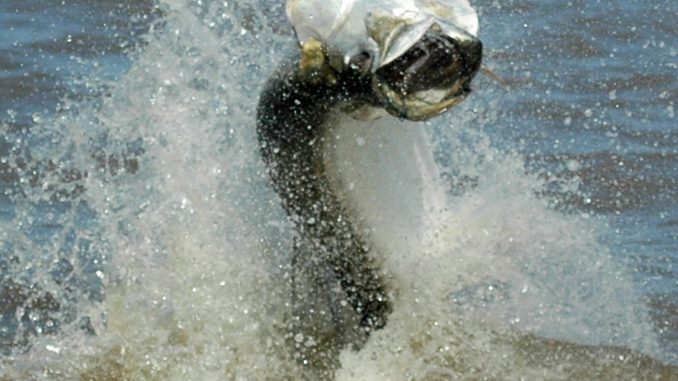
Although it’s time for the tarpon to be near Southport after having traveled up the Atlantic seaboard from Florida, they have been a little late arriving this summer.
“It’s been a strange year,” said guide and software expert Tommy Rickman, who lives within half a cast of the small-boat ramp at the new Southport Marina. “Everything’s been about two weeks late (showing up). It may have something to do with the weather.”
Rickman, who pursues red drum, flounder, speckled trout, king and Spanish mackerel, often makes time at the end of a working day for a trip just across the harbor from the quaint 300-year-old town.
“You try to find a channel near a sandbar, a dropoff that goes from 3- or 4-feet deep down to 16- to 20-feet,” Rickman said.
He anchors his 22-foot Pathfinder in the channel, facing the wind or tide (incoming or outgoing), then uses 7-foot stiff-spined rods with 80- to 100-pound-test leaders and Shimano TDD 25 reels spooled with 40-pound test monofilament to fish for tarpon.
His terminal tackle includes a three-way swivel with one or two 3- or 4-ounce pyramid sinkers (strong tides demand two sinkers) attached with 12-pound-test line and a drop line with an 8-0 medium circle hook where he impales one or two large menhaden.
“I use the 12-pound-test to tie on the sinkers so when the tarpon jumps, he’ll break them off and you’ll be fighting the fish without any lead weights,” Rickman said.
Best times to fish the creeks behind Bald Head Island are from dusk to 10 p.m. — or later, if one prefers.
“I put out three rods, two on the bottom and one on top (a surface lure) without a weight (and a live menhaden attached),” Rickman said. “Then it’s just a matter of waiting until Mr. Tar-Poon comes along.”
Rickman said a full moon night is best for tarpon, but it’s best to position baits on the moon side of the boat. Tarpon tend to jump toward the lighted moon, and it’s a pretty tough gig to have a 125-pound ‘poon jump into a boat at night.
“We fish the (Cape Fear River) shoals during the daylight hours,” Rickman said. “Tarpon like to school up out there; you can see ’em cutting through the sloughs.”
One key factor inshore is to watch for tarpon “rolling” on the surface.
“If you see tarpon rolling, you’ll almost always get a bite,” Rickman said.
The catch rate is probably one in 10, but that’s not extremely important to tarpon anglers.
The aerial tactics of hooked-up tarpon — tail walking, gill shaking, huge water splashes — are what make taking on silver kings a heart-thumping experience.
“It ought to start up good in about two weeks,” Rickman said July 23.





Be the first to comment